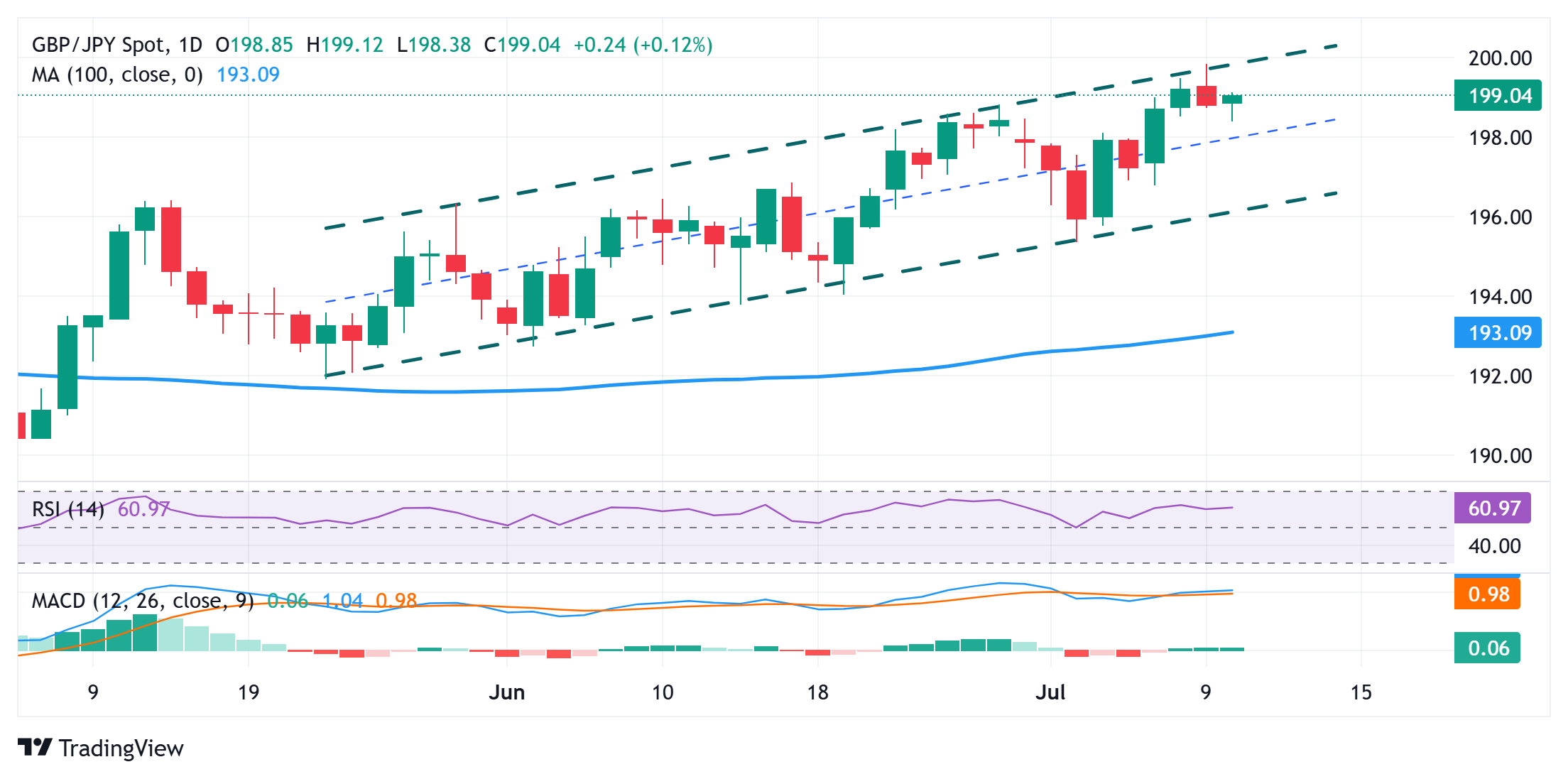GBP/JPY Price Forecast: Seems poised to retest YTD peak, near 200.00 mark
- GBP/JPY regains positive traction on Thursday and seems poised to appreciate further.
- The formation of an ascending channel points to a well-established short-term uptrend.
- A convincing break below the 196.00 mark is needed to pave the way for deeper losses.
The GBP/JPY cross attracts some dip-buyers near the 198.40-198.35 region during the Asian session on Thursday and stalls a modest corrective pullback from a one-year high touched the previous day. Spot prices currently trade around the 199.00 mark and seem poised to appreciate further amid a bullish technical setup.
The recent move higher witnessed over the past two months or so has been along an upward sloping channel, which points to a well-established short-term bullish trend. Moreover, oscillators on hourly/daily charts are holding in positive territory and are still away from being in the overbought zone. This, in turn, validates the near-term positive outlook and suggests that the path of least resistance for the GBP/JPY cross is to the upside.
Hence, a subsequent strength towards retesting the year-to-date peak, just ahead of the 200.00 psychological mark, looks like a distinct possibility. The said handle coincides with the top boundary of the aforementioned trend-channel, which if cleared decisively will be seen as a fresh trigger for the GBP/JPY bulls and set the stage for an extension of the pair's three-month-old uptrend.
On the flip side, the 198.40-198.35 region, or the daily low, now seems to protect the immediate downside ahead of the 198.00 round figure. A convincing break below the latter might prompt some technical selling and expose the next relevant support near the 197.15-197.10 horizontal zone. The GBP/JPY cross could weaken towards the 196.50 intermediate support before eventually dropping to the 196.00 mark, or the lower end of the trend channel.
GBP/JPY daily chart

Pound Sterling FAQs
The Pound Sterling (GBP) is the oldest currency in the world (886 AD) and the official currency of the United Kingdom. It is the fourth most traded unit for foreign exchange (FX) in the world, accounting for 12% of all transactions, averaging $630 billion a day, according to 2022 data. Its key trading pairs are GBP/USD, also known as ‘Cable’, which accounts for 11% of FX, GBP/JPY, or the ‘Dragon’ as it is known by traders (3%), and EUR/GBP (2%). The Pound Sterling is issued by the Bank of England (BoE).
The single most important factor influencing the value of the Pound Sterling is monetary policy decided by the Bank of England. The BoE bases its decisions on whether it has achieved its primary goal of “price stability” – a steady inflation rate of around 2%. Its primary tool for achieving this is the adjustment of interest rates. When inflation is too high, the BoE will try to rein it in by raising interest rates, making it more expensive for people and businesses to access credit. This is generally positive for GBP, as higher interest rates make the UK a more attractive place for global investors to park their money. When inflation falls too low it is a sign economic growth is slowing. In this scenario, the BoE will consider lowering interest rates to cheapen credit so businesses will borrow more to invest in growth-generating projects.
Data releases gauge the health of the economy and can impact the value of the Pound Sterling. Indicators such as GDP, Manufacturing and Services PMIs, and employment can all influence the direction of the GBP. A strong economy is good for Sterling. Not only does it attract more foreign investment but it may encourage the BoE to put up interest rates, which will directly strengthen GBP. Otherwise, if economic data is weak, the Pound Sterling is likely to fall.
Another significant data release for the Pound Sterling is the Trade Balance. This indicator measures the difference between what a country earns from its exports and what it spends on imports over a given period. If a country produces highly sought-after exports, its currency will benefit purely from the extra demand created from foreign buyers seeking to purchase these goods. Therefore, a positive net Trade Balance strengthens a currency and vice versa for a negative balance.
